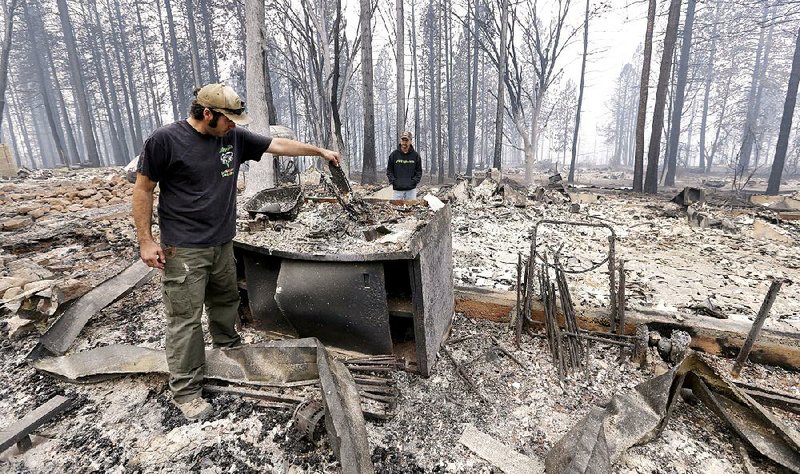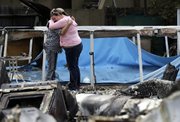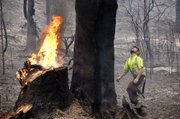MIDDLETOWN, Calif. -- California emergency officials said Monday that 23,000 people have been displaced by two wildfires sweeping Northern California.
One wildfire burned largely unchecked Monday after incinerating hundreds of homes and devastating rural communities north of California's Napa Valley, leaving at least one person dead and sending thousands of residents fleeing down flame-lined streets.
But it's not the only one. A second blaze, less than 200 miles away, destroyed 135 homes as it spread through Amador and Calaveras counties in the Sierra Nevada. That fire was 30 percent contained.
Both fires have displaced 23,000 people, Mark Ghilarducci, director of the Governor's Office of Emergency Services, said at a news conference with Gov. Jerry Brown.
Retired teacher Barbara McWilliams, 72, who was trapped in her home, died in the wildfire about 20 miles outside the famed Napa Valley, her family said Monday.
McWilliams had settled in the Middletown area in the past year, her family said. Her caretaker, Jennifer Hittson, told the Santa Rosa Press Democrat that McWilliams had advanced multiple sclerosis and had major physical disabilities that limited her ability to walk.
An unknown number of residents were unaccounted for. Some might be safe; emergency personnel and law enforcement planned to go to their last known locations once the danger subsides.
"These fires will take lives and they will cause injuries, and we have to do the best we can, because we are really in a battle with nature, that nature is more powerful than we are," Brown said.
Authorities flooded with requests for evacuation assistance could not rescue McWilliams, who called for help Saturday evening. The flames prevented deputies from reaching her subdivision, and rescue workers found her body when the fire subsided, Lake County sheriff's Lt. Steve Brooks said.
As tankers and helicopters waited on standby, flight commanders were unsure Monday whether they would be able to begin an assault on the Valley fire.
"It is the nightmare we feared," said Jeff Tunnell, a federal fire behavior specialist.
The Valley fire has prompted the local sheriff to declare it the worst tragedy the area had ever seen. With just 5 percent containment, even structures already ravaged by the fire are still under threat.
"The way it burned, it left so many pockets, the fire will turn around," incident planning chief Rob Daugherty said at a morning briefing with fire personnel. "If you saved the house, today you'll have to save the backside."
Although a dense, gray sky helped minimize the spread of the fire Sunday, it also kept aerial crews grounded because of its effect on visibility.
"We had a hard time actually finding where parts of the fire were," Daugherty said.
The same cloud cover a day later had crews worried that water and fire retardant would be delayed once more.
Smoke and dangerous conditions for air surveillance made it difficult for fire officials to assess how far through the hills the Valley fire had burned Sunday and where it had been most destructive.
The underlying cause is still under investigation, said Todd Derum, incident chief with the California Department of Forestry and Fire Protection, or Cal Fire.
"It was reported as a structure fire, but it was outside of the structure," Derum said at a community meeting for evacuees held at the Napa County Fairgrounds in Calistoga. He said wind-blown embers quickly began igniting "spot fires" a half-mile or more away in the drought-dried brush.
The fire exploded in size within hours as it chewed through brush and trees parched from four years of drought, destroying 400 homes, two apartment complexes and 10 businesses since igniting Saturday, Cal Fire spokesman Lynn Valentine said.
Crews have gained little control of the 95-square-mile blaze, which also damaged water distribution facilities and a complex of geothermal power plants known as the Geysers.
Five of the 14 plants were affected, including power lines and wooden towers that held cooling water, said Brett Kerr, spokesman for Calpine Corp. which runs the facilities.
Residents fled from Middletown, a town of more than 1,000 residents, dodging smoldering telephone poles, downed power lines and fallen trees as they drove through billowing smoke. Several hundred people spent Sunday night at the Calistoga fairgrounds.
Evacuees milled around eating, picking up donated clothing and walking their dogs. Nancy O'Byrne, 57, was evacuated from her home in Middletown, but it's still standing.
"I am very, very, very lucky. I have my house," she said, her dog Nellie at her side.
Michael Alan Patrick, 53, had been there since Saturday and lost his house in the blaze. When it broke out, he had been sitting in a park with his friends.
"It was like looking through a tunnel. You could see the flames coming," he said. "There was this big old pine tree, it lit up and it went whoosh and it was gone."
Whole blocks of houses have burned. On the west side of town, house after house was charred to their foundations, with only blackened appliances and twisted metal garage doors still recognizable.
"There are communities now, for example, Cobb, that have almost been 100 percent decimated," Cal Fire Chief Ken Pimlott said.
Four firefighters who are members of a helicopter crew suffered second-degree burns during the initial attack on the fire. They remained hospitalized in stable condition.
The governor declared a state of emergency Sunday to free up resources. He had already declared an emergency for the separate 111-square-mile wildfire about 70 miles southeast of Sacramento.
"The fires, once they start going, they start becoming very difficult to deal with and very expensive. ... We are going to have to make available increasing amounts of money," Brown said Monday.
Ghilarducci, of the Governor's Office of Emergency Services, said this summer's fires are the most volatile he has seen in 30 years of emergency response work. The main cause is the drought.
East of Fresno, the largest wildfire in the state marched away from the Sierra Nevada's giant sequoia trees, some of which are 3,000 years old, fire spokesman Dave Schmitt said. The fire, which was sparked by lightning on July 31, has charred 211 square miles and was 40 percent contained Sunday, the U.S. Forest Service said.
Firefighters have maintained a precautionary line around Grant Grove, an ancient grove of giant sequoia trees, and set prescribed burns to keep the flames from overrunning it. The grove is named for the towering General Grant tree that stands 268 feet tall.
Cattle Ranchers Worry
In other Western states, wildfires have burned large swaths of rangeland this year, killing cattle and leaving ranchers scrambling for space for their surviving herds.
The vast majority of the 1.6 million acres -- nearly 2,600 square miles -- that burned in Oregon, Idaho and Washington this year are federally owned, data show, with large swaths of that public land used as rangeland for livestock grazing.
In addition to rangeland lost, ranchers and ranching groups say hundreds of cows have perished and millions of dollars' worth of haystacks and barns have gone up in flames.
In northern Washington state, where the Okanogan Complex fire burned about 475 square miles and is considered the largest wildfire in state history, rancher Doug Grumbach found the burned carcasses of several cows on a hill among smoldering trees.
In total, eight of his cows and four calves died and 20 are still unaccounted for -- a loss of tens of thousands of dollars. He's also treating calves and cows with burned feet, severe body burns and respiratory problems.
Grumbach said he doesn't have enough unburned private land to feed his cattle; his cows are now eating hay meant for winter feed. And because of the drought, he doesn't have as much hay as usual, he said.
Many ranchers like Grumbach are desperately looking for pastures and hay, said Wyatt Prescott of the Idaho Cattle Association. Those who can't afford feed, he said, are sending their animals to sale yards.
Information for this article was contributed by Janie Har, Justin Pritchard, Eric Risberg, Daisy Nguyen, Kristin J. Bender, Olga R. Rodriguez, Gosia Wozniacka, Haven Daley, Elaine Thompson, Don Thompson, Paul Elias and John Antczak of The Associated Press and by Paige St. John, Hailey Branson-Potts, Lee Romney, Patrick McGreevy, Corina Knoll, Howard Blume and Matt Hamilton of the Los Angeles Times.
A Section on 09/15/2015



